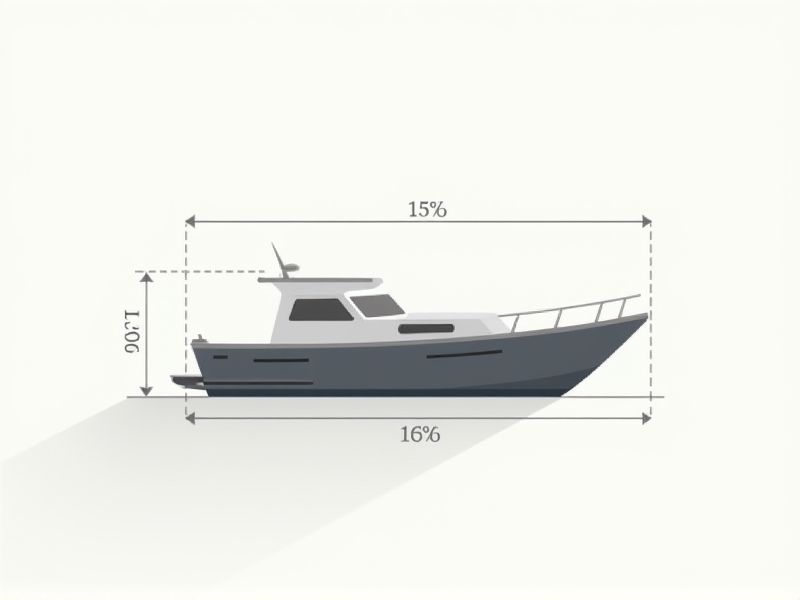
When considering the standard dimensions of boats, it's important to note that sizes can vary widely depending on the boat's purpose and type. For example, small recreational boats like kayaks typically range from 8 to 16 feet in length, while common fishing or pleasure boats often measure between 16 and 30 feet long, with a beam (width) of 6 to 10 feet. Larger vessels, such as yachts, start around 33 feet and can extend upward to 100 feet or more. If you're planning to purchase or build a boat, confirming the optimal dimensions for your activities--like fishing, cruising, or water sports--will ensure you get a vessel that meets your needs and local waterway regulations.
Length Overall
The Length Overall (LOA) is a critical measurement for boats, representing the maximum length from the bow to the stern, typically expressed in feet or meters. For example, a boat with a LOA of 30 feet offers ample space for navigation and amenities, making it suitable for both recreational and commercial use. When considering docking and storage options, the LOA influences the choice of marina facilities, which often impose size restrictions. Understanding your boat's LOA can also impact insurance rates and compliance with local maritime regulations.
Beam Width
The beam width of a boat, typically ranging from 6 to 15 feet, significantly influences stability and performance. A wider beam enhances stability, making it ideal for activities like fishing or leisure cruising, where comfort is paramount. Conversely, boats with a narrower beam, often under 8 feet, excel in speed and maneuverability, making them preferred for competitive racing. Your choice of beam width should align with your intended use to ensure an optimal boating experience.
Draft Depth
The draft depth of a boat, which refers to the vertical distance between the waterline and the lowest point of the hull, is crucial for ensuring optimal performance and safety. Typically measured in feet or meters, standard draft depths can range from 2 to 10 feet, depending on the size and type of vessel. Understanding your boat's draft is essential for navigating shallow waters and avoiding grounding. For example, a sailboat may have a draft of about 5 feet, while larger motor yachts can exceed 8 feet, significantly influencing your cruising capabilities.
Waterline Length
The waterline length (WLL) of a boat is a critical measurement that directly influences its speed, stability, and overall performance in the water. Generally, boats with a longer WLL tend to achieve higher speeds due to the decreased resistance when cutting through the water, making it essential for competitive sailing and racing vessels. Standard waterline lengths for various boat types range from approximately 15 feet for small dinghies to over 70 feet for large yachts. By understanding your boat's waterline length, you can determine optimal hull designs and plan effective sailing strategies to enhance your on-water experience.
Freeboard Height
Freeboard height, a crucial safety measure, refers to the vertical distance between the waterline and the top of a vessel's deck. For boats, the International Maritime Organization (IMO) recommends a freeboard height of at least 1.5 meters for optimal stability and safety in rough waters. Proper freeboard ensures that your boat remains buoyant and reduces the risk of taking on water during choppy conditions. Compliance with freeboard standards is essential for meeting regulatory requirements and enhancing overall vessel performance.
Displacement Volume
The displacement volume of a boat is crucial for determining its buoyancy and stability; it represents the volume of water displaced by the hull when the vessel is floating. This measurement is typically expressed in cubic feet or cubic meters, directly influencing the boat's load capacity, performance, and handling characteristics. For example, a displacement volume of 1,000 cubic feet indicates that the boat can support approximately 62.4 tons of water, which is essential for calculating cargo and passenger limits. Understanding the relationship between displacement and boat design enables you to optimize performance for various activities, such as fishing or cruising.
Bridge Clearance
Bridge clearance is a critical factor for boat owners, especially when navigating waterways with fixed structures. The average bridge clearance can range from 10 to 20 feet above the water, impacting your choice of vessel. Knowing the height of your boat, including any masts or equipment, is essential for preventing costly damage or accidents. By ensuring your boat adheres to these clearance standards, you can enjoy safe and uninterrupted passage under bridges.
Maximum Headroom
When selecting a boat, the maximum headroom is a critical aspect that impacts your comfort on board. Typically, boats offer headroom ranging from 6 to 7 feet, but some luxury vessels can provide more than 7 feet of clearance. Ensuring adequate headroom can significantly enhance your living space, allowing for easier movement and reducing the risk of accidental bumps. Choosing a boat with optimal headroom not only promotes comfort but also accommodates taller passengers, ensuring everyone can enjoy the voyage without constraints.
Cockpit Area
The cockpit area on standard boats typically measures around 5 to 8 feet in width, providing sufficient space for maneuverability and comfort. It usually features ergonomic seating arrangements, which can accommodate up to six passengers. The helm is designed with user-friendly controls, often integrating modern navigation systems and safety equipment to enhance your boating experience. Non-slip surfaces and strategically placed grab rails are essential safety features, ensuring secure movement while underway.
Cabin Space
Modern boats emphasize maximizing cabin space to enhance comfort and functionality. The average cabin size in contemporary yachts ranges from 10 to 25 square meters, accommodating seating for 4 to 8 people, depending on the model. Many designs incorporate versatile layouts, including foldable furniture and multi-use spaces, that can be transformed to suit various needs. With advancements in materials, the effective use of natural light, such as larger windows or skylights, can create a more spacious and inviting atmosphere within the cabin.
